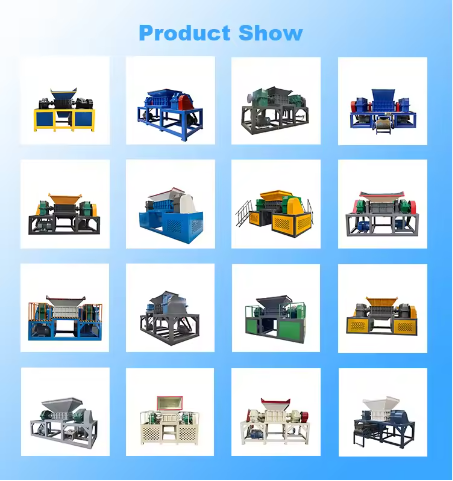Aluminum can shredder
Date:2024-08-23
View: Point
An aluminum can shredder is a specialized piece of equipment designed to efficiently reduce the size of aluminum cans, typically for recycling purposes. These shredders are commonly used in recycling centers, beverage manufacturing facilities, and waste management operations. Here’s an introduction to aluminum can shredders:
Key Components and Features:
- Heavy-Duty Design: Constructed with robust materials to handle large volumes of aluminum cans.
- Single or Double Shaft: Single shaft shredders are commonly used for aluminum cans, but double shaft designs can also be effective, especially for larger cans or mixed materials.
- Blades or Cutters: Equipped with high-performance blades or cutters that can shred cans into small, manageable pieces.
- Adjustable Output Size: Screens or grates are used to control the size of the shredded output.
- Automated Feeding: Many models include automated feeding mechanisms to streamline the shredding process.
- Safety Features: Includes safety interlocks, emergency stop buttons, and other protective measures to ensure operator safety.
- Easy Maintenance: Designed for easy access to internal components for regular cleaning and maintenance.
- Dust and Noise Control: Some models incorporate dust extraction systems and noise reduction features.
Working Principle:
- Feeding: Aluminum cans are fed into the shredder through a hopper or chute.
- Shredding: The cans are shredded by rotating blades or cutters inside the shredding chamber.
- Size Reduction: The shredded cans pass through a screen or grate, which controls the size of the output.
- Discharge: The shredded material is discharged into a collection bin or conveyor for further processing.
Applications:
- Recycling Centers: Processing aluminum cans collected from households and businesses.
- Beverage Manufacturing: Shredding aluminum cans produced during manufacturing or returned from customers.
- Waste Management: Managing aluminum waste in landfills or incineration facilities.
Benefits:
- Efficient Processing: Quickly processes large volumes of aluminum cans into smaller, more manageable pieces.
- Reduced Transportation Costs: Smaller, denser pieces take up less space, reducing transportation costs.
- Environmental Benefits: Helps manage aluminum waste sustainably and reduces the environmental impact of aluminum disposal.
Economic Value: Adds value to aluminum waste by converting it into a reusable resource

Zhongcheng Machinery Will Be There Whenever Wherever Whatever You Need
You Are Welcome to : phone call, Message, Wechat, Email& Seaching us, etc.
Email:
sales@zchmachinery.com
Whatsapp/Phone:
+8618738194110
hot Products
-
 Trommel screenTrommel screen, also known as drum screens, are widely used in various industries for sorting and separating materials.Get Quote
Trommel screenTrommel screen, also known as drum screens, are widely used in various industries for sorting and separating materials.Get Quote -
 Crop straw double shaft shreddApplications:Biomass Energy Production: Shredded straw can be used as a feedstock for bioenergy plants to produce electricity or heat.Livestock Feed: Reduced-si...Get Quote
Crop straw double shaft shreddApplications:Biomass Energy Production: Shredded straw can be used as a feedstock for bioenergy plants to produce electricity or heat.Livestock Feed: Reduced-si...Get Quote -
 Zhongcheng Air Drum SeparatorAir drum separators effectively separate lightweight materials (e.g., plastics, paper) from heavier materials (e.g., metals, glass). This high efficiency is cru...Get Quote
Zhongcheng Air Drum SeparatorAir drum separators effectively separate lightweight materials (e.g., plastics, paper) from heavier materials (e.g., metals, glass). This high efficiency is cru...Get Quote
relate news
-
2024-08-22Medical waste shredderWorking Principle:Feeding Mechanism: Medical waste is fed into the shredder through a hopper or chute. The feeding mechanism ensures that the waste is introduce...
-
2024-06-07Zhongcheng Air Drum Separator in MSWAir drum separators effectively separate lightweight materials (e.g., plastics, paper) from heavier materials (e.g., metals, glass). This high efficiency is cru...
-
2023-01-12Impact CrusherImpact crusher is a type of machine designed to reduce large rocks, ores, and other hard materials into smaller, more manageable pieces. This equipment is widel...
-
2023-01-12Waste Baler For MSWHigh density solid waste balers are the final step before sending waste to landfill. Horizontal balers designed and manufactured for this difficult job and prov...
-
2023-01-13Bag OpenerBag opener or bag opener system is a mechanical device used to automatically open and empty bags containing bulk materials. This system is commonly used in indu...



